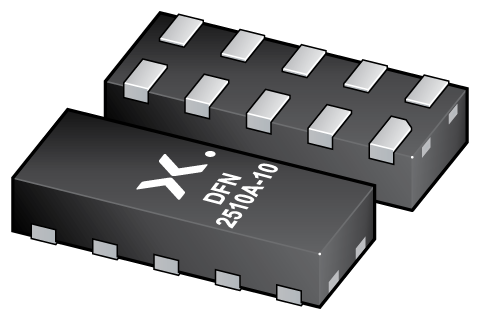
Register once, drag and drop ECAD models into your CAD tool and speed up your design.
Click here for more informationIP4284CZ10-TBR
ESD protection for ultra high-speed interfaces
The devices are designed to protect high-speed interfaces such as High-Definition Multimedia Interface (HDMI), DisplayPort, SuperSpeed USB, external Serial Advanced Technology Attachment (eSATA) and Low Voltage Differential Signaling (LVDS) interfaces against ElectroStatic Discharge (ESD).
The devices include high-level ESD protection diodes for ultra high-speed signal lines and are available in two package variants: XSON10 and TSSOP10.
All signal lines are protected by a special diode configuration offering ultra low line capacitance of only 0.5 pF. These diodes provide protection to downstream components from ESD voltages up to ±8 kV contact according to IEC 61000-4-2, level 4.
Features and benefits
- Pb-free, Restriction of Hazardous Substances (RoHS) compliant and free of halogen and antimony (Dark Green compliant)
- System ESD protection for USB 2.0 and USB SuperSpeed 3.0, HDMI 1.3 and HDMI 1.4, DisplayPort, eSATA and LVDS
- All signal lines with integrated rail-to-rail clamping diodes for downstream ESD protection of ±8 kV according to IEC 61000-4-2, level 4
- Matched 0.5 mm trace spacing
- Signal lines with ≤ 0.05 pF matching capacitance between signal pairs
- Line capacitance of only 0.5 pF for each channel
- 4-channel, XSON10 or TSSOP10 Pb-free package
- Design-friendly ’pass-thru’ signal routing
Applications
The devices are designed for high-speed receiver and transmitter port protection:
- TVs, monitors
- DVD recorders and players
- Notebooks, mother boards, graphic cards and ports
- Set-top boxes and game consoles
Parametrics
| Type number | Package name |
|---|---|
| IP4284CZ10-TBR | DFN2510A-10 |
Package
All type numbers in the table below are discontinued.
| Type number | Orderable part number, (Ordering code (12NC)) | Status | Marking | Package | Package information | Reflow-/Wave soldering | Packing |
|---|---|---|---|---|---|---|---|
| IP4284CZ10-TBR | IP4284CZ10-TBR,115 (934065614115) |
Obsolete |

DFN2510A-10 (SOT1176-1) |
SOT1176-1 | SOT1176-1_115 | ||
| IP4284CZ10-TBR/S50 (934066057115) |
Obsolete | SOT1176-1_115 | |||||
| IP4284CZ10-TBR/LCX (934068694115) |
Obsolete | 84 empty empty | SOT1176-1_115 |
Environmental information
All type numbers in the table below are discontinued.
Documentation (8)
| File name | Title | Type | Date |
|---|---|---|---|
| IP4284CZ10-TBR_TT | ESD protection for ultra high-speed interfaces | Data sheet | 2011-05-20 |
| AN10910 | Protecting charger interfaces and typical battery charging topologies with external bypass transistors | Application note | 2021-04-12 |
| Nexperia_document_brochure_ESD-Protection-Applications_022017 | ESD Protection Application guide | Brochure | 2018-12-21 |
| SOT1176-1 | 3D model for products with SOT1176-1 package | Design support | 2023-02-02 |
| SOT1176 | 3D model for products with SOT1176 package | Design support | 2019-10-03 |
| Nexperia_package_poster | Nexperia package poster | Leaflet | 2020-05-15 |
| DFN2510A-10_SOT1176_mk | plastic, extremely thin small outline package; 10 terminals; 0.5 mm pitch; 2.5 mm x 1 mm x 0.5 mm body | Marcom graphics | 2017-01-28 |
| SOT1176-1 | plastic, leadless extremely thin small outline package; 10 terminals; 0.5 mm pitch; 2.5 mm x 1 mm x 0.5 mm body | Package information | 2022-06-07 |
Support
If you are in need of design/technical support, let us know and fill in the answer form we'll get back to you shortly.
How does it work?
The interactive datasheets are based on the Nexperia MOSFET precision electrothermal models. With our interactive datasheets you can simply specify your own conditions interactively. Start by changing the values of the conditions. You can do this by using the sliders in the condition fields. By dragging the sliders you will see how the MOSFET will perform at the new conditions set.
